
views
Building Your Blog

Find a place to host your blog. There are several great platforms where you can build a blog for free. You can use WordPress, Substack, Weebly, Webnode, and many more. To get an idea of which one to use, visit the site and search for "travel." You can then peer through other travel blogs hosted on the same site and see what styles you enjoy. Each hosting site will offer a different strength. WordPress is quite user-friendly for beginners, while Substack allows your blog to function more as a newsletter. Even Tumblr remains a viable option, perhaps for writers who plan to emphasize pictures in their posts. While almost all blogging sites offer a free version, some also offer paid versions that grant you access to a wider variety of features and customization options. Consult these options carefully when deciding what is best for your blog and its long-term ambitions.

Purchase a domain name. If you're looking to be a professional travel writer, you should consider buying a domain name. Having a site URL like www.myadventures.wordpress.com is good for smaller blogs, but it looks a lot less professional than www.myadventures.com. You can host your blog on any site and have it redirect to a URL that you own.

Think of your unique angle while traveling. What makes your blog stand out amongst the thousands of other travel blogs out there? Establish a style and stick to it. Try to pick up on a new trend or become an authoritative guide on something people want to know about. Think about your reasons for writing a blog -- what do you want the world to know about you and your travels, and what caused you to start your blog in the first place? Is your blog just meant to keep friends and family in the loop about your travels, or do you hope to reach a wider audience? What kind of perspective do you bring to a new place or country? Are you a foodie looking to compare different recipes, or an expat adapting to a new culture? Perhaps a photographer looking to capture something new? What can you teach people from your trip? Are you an inventive budgeter, a student of art and history, or a camping guru?

Think about your blog's angle when designing your page. All blogging sites come with "Templates," which are pre-made websites that allow you to focus on the content, not coding. That said, you need to choose a design that best showcases your talents and travels. Remember, you can always change this later, too, if your blog changes focus. Pictures: If you plan on using a lot of photos, choose a layout that offers lots of pictures on the screen at once. Many layouts have a homepage or top bar with slideshows or a collage of your pictures, making them front and center for your viewers. Often, these templates show off big, high-quality photos. Essays: Consider your margins and your font here. You want a layout that is easy to read and doesn't distract viewers from the words on the page. Mixtures: If you plan on posting a bit of everything, consider a simple, scrolling design. These usually give small clips of pictures or text in chronological order, with the latest post up top, allowing your viewer to scroll through and get an idea of what each post is about.

Choose a short, memorable name. Puns, plays on words, and alliterations (using the same letter twice, such as "Timmy's Travels") are generally safe bets, but choose a name that speaks to you. Keep it short so that it is easily memorized and people know how to look you up. Try to avoid hyphens, numbers, and odd symbols or spellings whenever possible. Make sure your URL and blog name are the same. This will help people find your blog, and it'll make returning users less confused. Avoid changing your domain name and/or blog name frequently, if at all. You should decide on one blog name in advance that you know you won't change later. Try not to look like you're impersonating an existing blog or company. Search your blog name to see if there are companies with similar names, and try changing it. If you plan on blogging from a single location, consider incorporating that new city or country into your title.
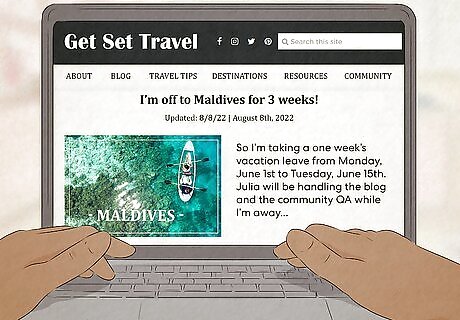
Plan when and how you can post while abroad, and let your readers know. Before you leave, check out your accommodations and determine when you'll be able to post something. Blogging should enhance your trip, not get in the way of it! If you're not able to post frequently or need to cut your experiences short to run to an internet cafe, you may not get the most out of your trip. However, a bit of pre-planning can save you the hassle: Know when you will have time to write posts and let people know your "posting days." When out of service, write multiple posts. You can then schedule them all when you're back in internet range. Learning how to use your site's "Schedule Post" allows you to write many posts at once, then put them up every few days. This is perfect if you'll be leaving service again.
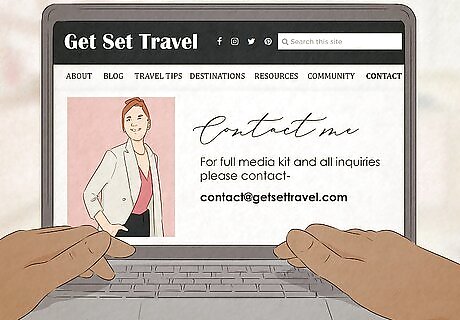
Set up your blog's pages. While your posts will be your blog's main attraction, each blog layout will include options for an About or a Contact page as well. Be sure to write a short bio for yourself, explaining who you are and why you are passionate about travel! The "Contact" page can also be a good way to receive feedback on your writing, and to redirect readers to your social media pages.
Writing Great Content

Make an enjoyable trip your first priority. You can't write engaging, enjoyable content if you're not engaged with your trip. The best writing comes out of the experience, but you can't get that experience if you're always holed up on your computer or looking through a camera lens. Set aside time for writing, but move on to other things when that time is over. Oftentimes, writing is best at the very end of the day, right before bed, or right when you wake up. You'll be able to reflect on the day you just had, then move on to the next one. Be sure to take lots of pictures while you travel. Your readers will love to see lots of visuals related to your topic. And even if you choose not to include them in your work, they will act as helpful visual cues/reminders while writing!
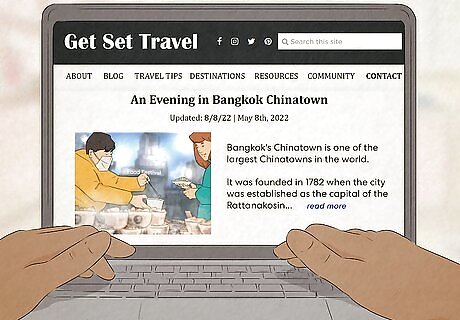
Brainstorm ideas for posts based on your experiences. Find ways to put the viewer next to you on your adventures, making them feel like they are traveling too. For example: Dedicate posts to describing cultural differences, like a post on food, a post on public transportation, a post on morning rituals, etc. Dive deeply into one specific area, like a neighborhood or a hidden location. Teach your readers how to do something, like how to plan their own trip, how to dress like a native, how to order at a restaurant, etc. Travel blogging should remain insightful and informative, but don't be afraid to add a personal touch! Making yourself familiar to your readers is what will keep them coming back for more.

Write or post every few days. The more you write, the better you will get at it. Even better, frequently updated sites will appear more often in search engines, and viewers are likely to keep coming back if they can be sure there will be new content waiting for them. Stick to the schedule you promised your readers as much as possible. If you promised three posts a week, try not to publish any more or any less.
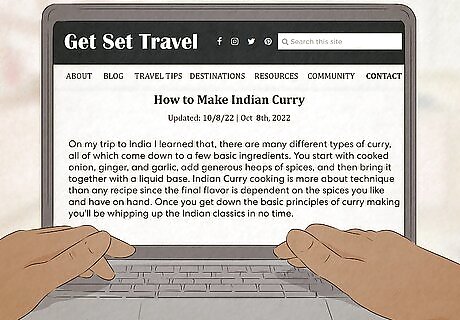
Diversify your posts. While you want to stay on your general theme, mixing up your posts here and there is a great way to keep your readers, and yourself, interested. If you normally write essays, post a funny personal story or a photo collage. If you're mostly focusing on food and recipes, take a day and go into a market or grocery store, or interview a cook about their method of cooking. The best part is that expanding your horizons like this will make the actual travel more enjoyable, as you'll peer into unexpected corners and cultures. You may be writing a blog, but feel free to consult professional travel writing for inspiration as well. Publications like Outdoor Magazine and National Geographic may have covered similar topics or locations.
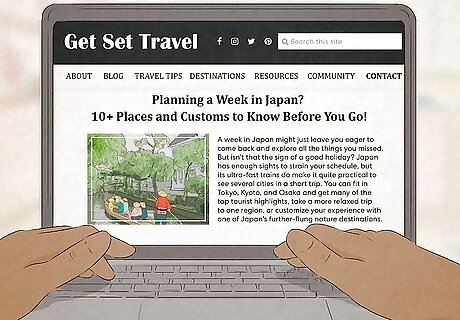
Add visuals, music, and imagery. Even if you're not a great photographer, a few pictures in every article captures people's imaginations and makes them likely to stop and read. A page filled with nothing but words is intimidating, but the same content with 2-3 pictures mixed in seems much more appealing. Take some videos of great events or post a link to a song you heard. Engage the reader as much as possible so that they feel like they're on your trip with you. If you don't have any photos or videos of your own, you can still find high-resolution images online to complement your writing. Just don't pass such pictures off as your own! If you need to edit your photos, there are several free and paid photo editors out there. Pixlr and VSCO are two user-friendly options, while Adobe Photoshop remains the industry standard for those more comfortable with their photo editing skills.
Monetizing Your Blog

Build a media kit. The most lucrative way to monetize your blog is finding sponsors. But your first need to look professional to potential sponsors before they pay you to promote them. A media kit, sometimes referred to as an EPK, should include everything you want people to know about your blog and its brand identity.
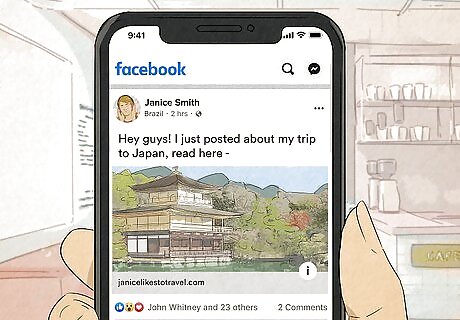
Use social media accounts to promote your blog. If you're a writer, send out tweets with your thoughts and links to the blogs. If you're a photographer, there is no better way to get exposure and practice than Instagram. And if you want friends and family to read, tap into your pre-made network of friends on Facebook. All blogging platforms allow you to link the posts with a little button on the right or left side (or found on the "Settings" page), which means the site will automatically post things to social media for you every time you post a blog post. Social media is your friend, and it is the best way to get your work out there. If you are interested in finding corporate sponsors, Instagram may be your best bet for self-promotion. Several companies scour Instagram for influencers to provide with online codes or product samples.
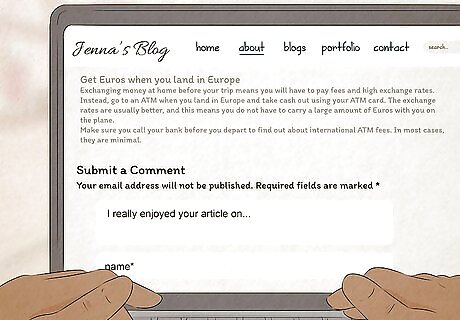
Comment on other related blogs. Offer to write content for them and link back to your own site. If your content is interesting enough, then you will build a fan base naturally. You might also get travel tips from others that have been there, and get ideas for new posts or topics to tackle. Be sure to familiarize yourself with SEO so your own posts can be found as easily as possible online.

Set up an affiliate marketing account. There are several ways to run ads on your blog, but we recommend finding some affiliate partners. Many popular travel booking sites offer affiliate programs, including Booking.com or RentalCars.com. You can also join the TravelPayouts network, which grants you access to a wide network of travel affiliates to incorporate into your posts. With an affiliate program, you are given a personalized link. Simply distribute this link in your posts, and receive a kick-back when users click the link and make a purchase. You are probably already recommending various services and attractions in your writing anyway, so why not monetize those recommendations? While you may also consider contextual advertising through a service like Google Ads, or selling ad space the old-fashioned way, affiliate marketing strikes the best balance between proper payout and ease of use. Once you have built a large enough of a following, you may find it quite easy to sell your own ads, maximizing your profits along the way.

Set up a subscription model for your blog. While you want to keep your blog open and free in its early stages, you may consider converting to a subscription model once you have developed a proper fanbase. You could require a paid subscription to access your blog, or simply offer bonus articles/resources behind a paywall. Because your blog would take the form of a newsletter, Substack might be the best service to use if you want to explore a subscription model.
















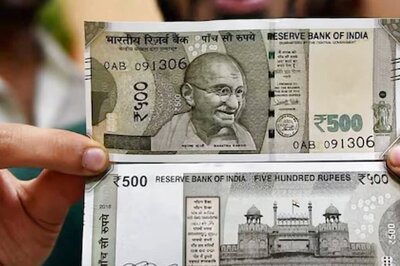



Comments
0 comment